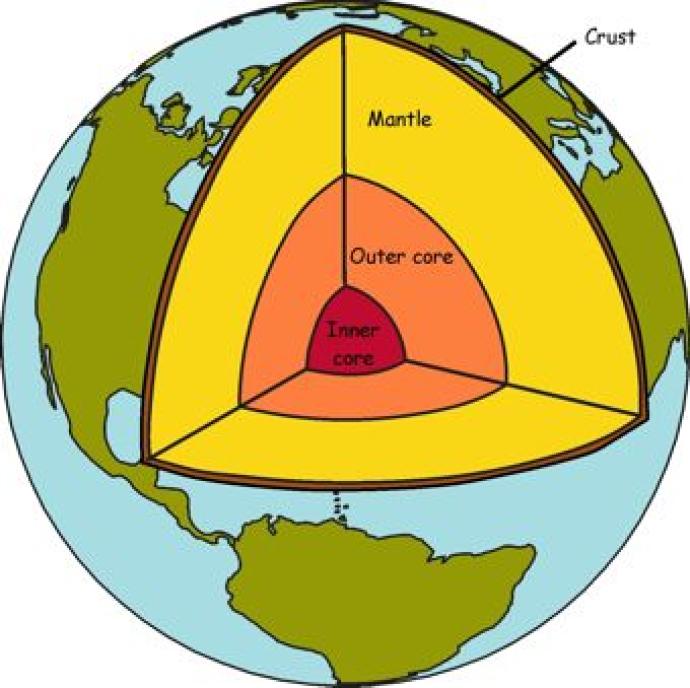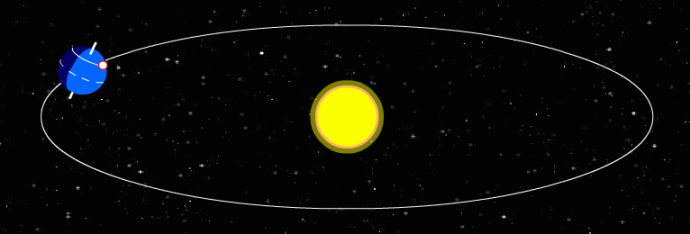Earth is the third planet from the Sun. It is the largest of four rocky, or terrestrial, planets. It is the only place in the Universe where we know there is life.
The Earth has an atmosphere, which we call 'the air'. It is mostly made of nitrogen (78%) and oxygen (21%). It also contains tiny amounts of water vapour, carbon dioxide, and other gases.
About 70% of Earth's surface is liquid water. This creates large oceans and seas. The rest is continents and islands. The areas near the north and south poles of the Earth are mostly covered with ice and are called the polar regions.
The inside of the Earth is split into layers. There is a solid iron core in the middle. This is surrounded by a liquid outer core. Around this is the mantle and a crust.
The Earth turns on its axis as it orbits the Sun. Each turn takes 24 hours or 1 day. It takes 365.25 days, or one year, to complete an orbit around the Sun.
The Earth has seasons because its axis is tilted by about 23°. When the northern half of the Earth (Northern Hemisphere) is pointing towards the Sun it has summer. At the same time the Southern Hemisphere is pointing away from the Sun and has winter. This switches as the Earth moves around its orbit.
Earth has one large rocky satellite, called the Moon. It is a natural satellite, meaning it is not human-made. It orbits the Earth once each 27.3 days. The Moon is the fifth largest natural satellite (or moon) in the Solar System.

- Day and Night
We get day and night because the Earth spins on its axis. It takes 24 hours to spin around once, so it rotates once a day. The Earth spins at over 1,500 km an hour! That's more than 4 times faster than a Formula 1 car racing at top speed!
It is always daytime on the side of the Earth facing the Sun and night on the side facing away from the Sun. The Sun appears to move across the sky because the Earth is spinning.
The Earth rotates from west to east. This is why the Sun rises in the east and sets in the west. Remember, the Sun always stays where it is in the centre of our Solar System!
Sky during each season
Season Horizon View (300KB) World View (250KB) Spring View Movie View Movie Summer View Movie View Movie Autumn View Movie View Movie Winter View Movie View Movie What you see also depends on where you are in the world! The Earth is a globe, so our view of the sky varies from place to place. Because the Earth is tilted on its axis as it orbits the Sun, you get a different view at different times of year.
Why not watch our whole sky movies to compare views. They help you see how things change for different months of the year, and different locations around the world. Just choose a movie from the table.
Location March June September December Arctic View Movie View Movie View Movie View Movie Europe View Movie View Movie View Movie View Movie North America View Movie View Movie View Movie View Movie Africa View Movie View Movie View Movie View Movie Australia View Movie View Movie View Movie View Movie Antarctica View Movie View Movie View Movie View Movie - Earth's Orbit
The Earth orbits the Sun at a speed of around 30 kilometres per second!
It takes the Earth 365-and-a-quarter days to go all the way around the Sun once. One year is 365 days, so every four years we add up the extra four quarters to make one extra day. That year has 366 days. We call it a 'leap year'.
While the Earth orbits the Sun, it also spins around on its axis. It takes the Earth 24 hours (one day) to complete one full spin. The Earth's axis is an imaginary line through the Earth from the North Pole to the South Pole.
Image CreditThis work by Guka121 is licensed under Creative Commons Attribution 4.0 International
CreditThis work by Guka121 is licensed under Creative Commons Attribution 4.0 InternationalEarth's orbit around the Sun
